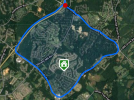It is mis-leading, but that is what I have to work with. (most suburban appraisers in my area do it the same way).
Keep in mind:
1. I am only speaking to Fannie Forms.
2. Using UAD and Fannie Mae guidelines.
That being said, how can one use the appraisal institutes definition of a neighborhood when adhering to Fannie Mae guidelines and UAD requirements? Please read what the UAD and Fannie Mae says about there take on what is a neighborhood. It is much different than the "According to the Dictionary of Real Estate Appraisal, a neighborhood is, “A group of complimentary land uses; a congruous grouping of inhabitants, buildings, or business enterprises.” A neighborhood is typically larger than a subdivision or builder’s development; because, neighborhoods normally include supporting businesses like neighborhood grocery stores."
HERE IS WHAT I DEAL WITH. I MOSTLY APPRAISE IN A SUBURBAN AREA: ****CLICK TO EXPAND****
1. The below map has about 5 different PUD's and subdivisions of varying market appeal, ages, quality, GLA and price points.
2. The below is the defined neighborhood boundaries.
So for the "neighborhood" on the URAR, I put in the subdivision name in which the subject is located in.
The neighborhood below has a school, shopping centers, retail, and a golf course.
So what do I do? There is not a so called "neighborhood name". It is either this or none:
1. Use the subdivision name and draw the neighborhood boundaries as the subdivision boundaries (platted). **To narrow**
2. Use the town name as the neighborhood which expands for 4 miles and across major though fares. **To wide..market area.**
3. Use the subdivision name and draw my neighborhood boundaries to include other PUD's and retail centers. ***I do this**
The issue with 2 and 3 above, is that it is easy for the appraiser to hide or mis-lead when the subject is a over improvement. What about the subjects "predominate"? If you use all of the subdivisions, it will not accurately describe the subjects predominate for the subdivision. Within the defined boundaries, there is a $200K project, $350k project and a $350-$500k project. The predominant is $350. So if you are appraising a home in the $200k subdivision, there would never be a over-improvement in the subjects subdivision. On the other hand, if I draw my boundaries to include only the subdivision, it would never include any commercial land uses. (we do have some mixed use developments, but lets keep it the example simple)
That is why the new forms needs to have a "subdivision and a separate market area section to fill out.
If you ask the neighbors what "neighborhood" they live in, they would name their subdivision. Urban and rural areas are different.
View attachment 49192
Which one is worthy of a professional-level fee? The first one clearly says too little; the second one probably says too much.

www.workingre.com



